by Evan Randolph
Basic
Thesis:
Athena was the Holy Spirit of
Constantine / Council Nicea
LATEST
DISCOVERIES:
ATHENA DISPENSES GRACE (CHARIS) TO TRANSFORM US
2700
yr old hidden texts found-
Athena linked to Divine Wisdom
click
here for details
ATHENA GIVES SOUL (PSUCHE) TO MORTALS
1900
yr old texts just located-
links Athena to creation
click
here for details
ATHENA TIED TO BREATH (PNOE)
PNOE
only appears twice in the New Testament
click
here for details
GOD'S BREATH (PNOE) & SOUL (PSUCHE) AT CREATION GEN
2:7
click
here for details
ST AUGUSTINE SAYS THIS BREATH (PNOE) IS "THEIR
SPIRIT"
his
1600 yr old text links "pnoe" to Divine Wisdom
click
here for details
CONSTANTINE & COUNCIL ESTABLISH TRINITY-
DIVINE WISDOM (an evolution of Athena) IS THE HOLY SPIRIT
ST. AUGUSTINE CONFIRMS MINERVA (ATHENA) AS HOLY SPIRIT
click
here for details
 BACKGROUND ON ROMAN TRINITY- Minerva part of Capitoline Triad-
BACKGROUND ON ROMAN TRINITY- Minerva part of Capitoline Triad-
Built
in 509 BC, the largest temple in Rome
was called Jupiter Optimus Maximus on the Capitoline Hill.(see
footnote 1)
The interior of the temple was divided into three
rooms, dedicated not only to Jupiter but also to his consort Juno
and the
goddess Minerva. Collectively they are known as the Capitoline
Triad, and when Roman power had expanded to encompass an empire,
the central temple of many Roman cities - in Italy and further afield
- was often dedicated to this Capitoline Triad. (see footnote
2)
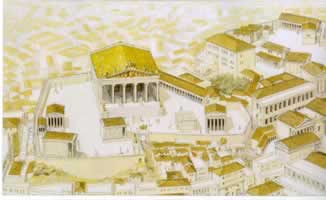
Temple
of Jupiter Optimus
Maximus on Capitoline Hill, Rome-
The Ancient City, Peter Connolly & Hazel Dodge, Oxford Press,
p. 170
Minerva (Athena) was a member of the Roman Trinity
(Capitoline Triad)
500 years prior Christ.
 Constantine
the Great (272-372 CE) believed the Palladium (a statue of
Athena) protected Rome.
Constantine
the Great (272-372 CE) believed the Palladium (a statue of
Athena) protected Rome.
Constantine "diminished none of the priveleges
of the sacred virgins---" Quote from Symmachus references
the late emporer Constantine's policy. (see footnote 3)
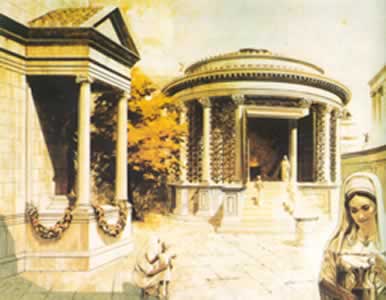
The circular Temple of Vesta- The Ancient City,
Peter Connolly & Hazel Dodge, Oxford Press, p. 172
The priestly office of the College of Vestal Virgins was created by
the second King of Rome. The Vestal Virgins
guarded the Palladium and kept the sacred fire burning. (see
footnote 4)
The Palladium was an image of Pallas Athena
on which the safety of the city depended (see footnote
5),
In Greek & Roman writings, Odysseus and Diomedes stole the Palladium
from Troy and thus
defeated the city. (see footnote 5)
The College of Vestal Virgins ended in 391 CE when disbanded by Theodosius
I. (see footnote 4)
Shortly thereafter, in 410 CE- the Visigoths sacked
Rome (see footnote 6)
Constantine
honors Athena & Nike by placing them above his army on his Arch
commemorating his victory. Constantine defeated Maxentius
at Milvian Bridge in 312 CE. The Arch of Constantine was erected in
315 CE to celebrate this victory. The medallions and copy on this
Arch show Constantine's appreciation of the support of Athena &
Nike in his victory. (see footnote 7)
[THIS IS A NEW FINDING- NOT LISTED ON GOOGLE]
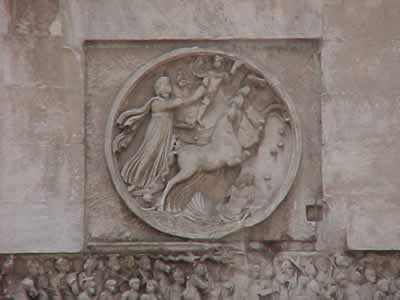
Athena
in chariot with Nike above rising above opposing force. This
medallion appears on Constantine's Arch
directly above scene of Constantine's army leaving Rome to meet Maxentius.
(see footnote 8)
This scene above portrays
the Orphic Hymn to Athena "You driver of steeds... bearing Victory
in your arms!" ( see
footnote 9)
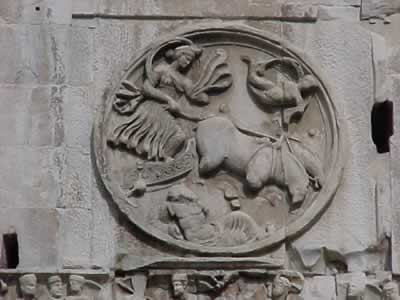
Athena in chariot with Nike above coming down on opposing
force. This medallion appears directly above
scene of Constantine's army (after victory over Maxentius) entering
Rome in triumph. (see footnote 8)
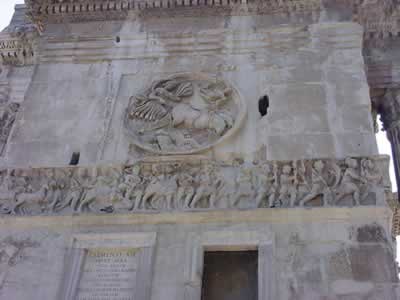
Here is the complete
scene showing Athena & Nike directly above Constantine's
army
entering Rome in triumph, Constantine in his chariot on the left.
(see footnote 10)
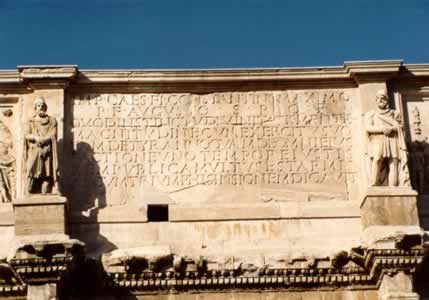
Constantine
honors Athena goddess of wisdom when he states on his Arch
(lines 3 & 4 above):
"...quod instinctu
divinitatis mentis magnitudine..."
this translated: "...since
through divine inspiration and great wisdom..."
(for inscription- see footnote 8, translation- see footnote 11)
In
330 CE Constantine moved his seat of government from Rome to
Byzantium, later called Constantinople. (see footnote
12)
Constantine the Great erected the first church of Hagia
Sophia (Divine Wisdom) in Byzantium.(see footnote 13)
Few structures remain of Constantine's Byzantium except a huge column
which he erected.(see footnote 14)
This column stands 120 feet high. Constantine topped it with a colossal
bronze statue of Apollo, supposedly the work of Phidias. Underneath
this pillar, it is said that Constantine
had buried the Palladium which he had removed from Rome.
(see footnote 15)
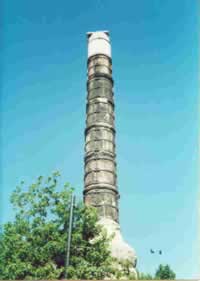
Constantine's 120 foot column in Constantinople with the Palladium
buried underneath. (see footnote 16)
 The Athena statue in the Parthenon was huge and in place for
The Athena statue in the Parthenon was huge and in place for
867 years (until destroyed by Christians).
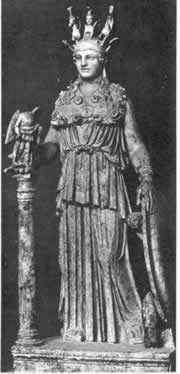
Athena Parthenos, Greek goddess of Wisdom. (Parthenos
means Virgin). This statue reproduces, with a slight variation in
posture, the celebrated Athena Parthenos by Phidias in the Parthenon.
The huge statue, approx. 42 feet tall, dominated the interior
of the Parthenon in Athens, Greece. She held a shield upright
with a snake coiled within it; the other hand held a Nike (Victory).
Phidias' massive statue of Athena stood in the Parthenon 438 BCE until
429 CE, a total of 867 years.The reproduction above is 2nd
century CE. Athens Museum. New Larousse Encyclopedia
of Mythology, p. 107
Athena's dress was covered in gold,
the value of which in today's dollars would be $12,000,000.
(see Footnote 23)
 Here
is a full sized reproduction of Athena-
Here
is a full sized reproduction of Athena-
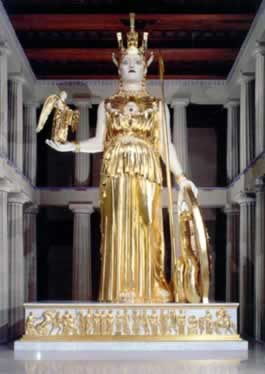
This
full-scale replica of Athena Parthenos, Greek goddess of Wisdom,
is 41 feet 10 inches tall and weighs 12 tons. The goddess of
victory (Nike) in Athena's right hand is 6 feet 4 inches tall. (see
Footnote 24 ref Athena statue)
Located in Nashville, TN, Athena Parthenos is the centerpiece of a
full scale replica of the ancient Parthenon.
(see Footnote 25 ref Parthenon, Nashville)
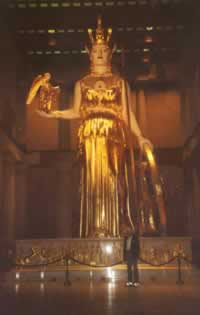
Here is Evan Randolph
(lower right) standing in front of 42 foot statue of Athena
in the Parthenon, Nashville. Note how Evan's Nike sneakers lit up
for the occasion.
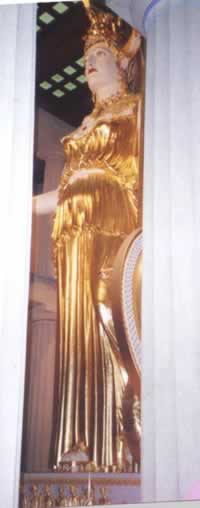
42 foot Athena
as seen from the side between the pillars of the Parthenon, Nashville.
 IN
ANCIENT GREECE- ATHENA, GODDESS OF WISDOM, WAS WELL KNOWN-
IN
ANCIENT GREECE- ATHENA, GODDESS OF WISDOM, WAS WELL KNOWN-
 Plato
(429-348 BCE) states that the Goddess Athena is both "...a
lover of war and a lover of wisdom..." (see Plato Timaeus
24d- footnote 26).
Plato
(429-348 BCE) states that the Goddess Athena is both "...a
lover of war and a lover of wisdom..." (see Plato Timaeus
24d- footnote 26).
Plato Cratylus 407a-b - "The ancients seem to have had
the same belief about Athena as the interpreters of Homer
have now; for most of these, in commenting on the poet, say that he
represents Athena as mind (nous) and intellect (dianoia); and
the maker of names seems to have had a similar conception of her,
and indeed he gives her the still higher title of "divine
intelligence" (hê theou noêsis), seeming to
say: This is she who has the mind of God (Theonoa)..."
(see footnote 26)
Plato wrote about wisdom in a female
context; she can be found in all her purity in the other world, where
the souls go after death. (Plato, Phaedo, The Harvard Classics
1909, p. 57)
 800 BC- The
Greek goddess of Wisdom Athena appeared 162 times in HOMER'S
ODYSSEY. She came down from heaven and provided significant help
to Odysseus in his earthly travails. (see footnote 27)
800 BC- The
Greek goddess of Wisdom Athena appeared 162 times in HOMER'S
ODYSSEY. She came down from heaven and provided significant help
to Odysseus in his earthly travails. (see footnote 27)
It is interesting that Athena & Odysseus planned the recovery
of Odysseus's wife and home on Apollo's grand festal day (Odyssey
20:307). This change around of Odysseus's fortunes, long in decline
and now on the upswing, occured at the Winter Solstice, then December
25th--Apollo's festal day! (see Footnote 28).
Apollo was a sun god, a healer-god, the god of divination and
prophecy, shepherd-god, in addition to archer-god
(New Larousse Encyclopedia of Mythology- pg 113) and was born on December
25th, the winter solstice.
"Christian antipathy to paganism is ungrateful,
since it derives every element of its theology, ritual and symbolism,
along with its sacred scriptures, from that source; it reconstructed
its entire dogma over the model of pagan, that is, of Platonic and
Aristotelian philosophy; it has perpetuated the celebration of most
of the pagan religious festivals; and, finally, it has adopted, as
its own policy, the pagan emphasis on esotericism." See footnote
29
 Early
Christians destroy Athena's statue in the Parthenon in 429 CE
Early
Christians destroy Athena's statue in the Parthenon in 429 CE
Athena installed in her Temple the Parthenon in Athens in 438
BCE, atop the Acropolis. (see footnote 30)
Athena remained enshrined inside the Parthenon until 429 CE (a total
of 867 years), when "The Temple of Goddess Athena (Parthenon)
on the Acropolis of Athens is sacked." (see Footnote 31)
"The Christians, under the emperor Theodosius II, removed
the statue to Byzantium, where it was stripped of its
gold and destroyed without a trace." (see Footnote 32)
 630
CE- ATHENA'S TEMPLE NAMED AFTER DIVINE WISDOM--
630
CE- ATHENA'S TEMPLE NAMED AFTER DIVINE WISDOM--
"The most important symbol of Greek heathenism, the Parthenon,
was changed in the seventh century into a church for Aghia Sophia,
the divine wisdom..."
(see footnote 33)
This shows beyond any doubt that the Christian
Church linked Divine Wisdom to Athena.
"It is by no means coincidence that the chief temples of Pagan
Athens and Christian Constantinople were both dedicated to Wisdom.
The Parthenon as the shrine of the Goddess Athena, Goddess of Wisdom,
and Justinian's Great Church both showed respect for "Sophia"
which has always been one of the chief traits of the Greek mind."
(see footnote 34)
The
Return of Athena--- reclaiming our universal protectress
FOOTNOTES:
Footnote 1
http://en.wikipedia.org/wiki/Jupiter_(god)
Footnote 2
http://www.bbc.co.uk/history/ancient/romans/roman_religion_gallery_02.shtml
Footnote 3
http://encyclopedia.laborlawtalk.com/Constantine_I_(emperor)
Footnote 4
http://en.wikipedia.org/wiki/Vestal_Virgin
Footnote 5
http://en.wikipedia.org/wiki/Palladium_%28mythology%29
Footnote 6
http://www.musesrealm.net/rome/timeline.html
Footnote 7
http://www.architectour.com/1.htm
Footnote 8
http://myweb.lmu.edu/fjust/Rome-ArchConst.htm
Footnote 9
http://www.commonplacebook.com/inspire/athena/hymns.shtm
Footnote 10
http://www.historyforkids.org/learn/romans/art/archconstantine.htm
Footnote 11
http://sights.seindal.dk/sight/299_Arch_of_Constantine-2.html
Footnote 12
http://www.yasou.org/byzantium/byz.htm
Footnote 13
http://www.sisantours.com/hag_sop.html
Footnote 14
http://www.omhros.gr/Kat/History/Rel/Mos/Istanbul.htm
Footnote 15
http://gd.cnread.net/cnread1/ewjd/g/gibbon/hor/065.htm
Footnote 16
http://www.geocities.com/constantine325ist/early.html
Footnote 17
http://www.antipas.org/books/trinity/trinity1.html
Footnote 18
http://www.gutenberg.org/dirs/etext99/uthyd10.txt
Footnote 19
http://www.chroniclesmagazine.org/Chronicles/December2002/1202Wolf.html
Footnote 20
http://www.ethicalatheist.com/docs/flat_earth_myth_ch5.html
Footnote 21
http://www.goddess-athena.org/Museum/Paintings/index.htm
Footnote 22
http://www.cornellcollege.edu/classical_studies/myth/athena/index2.html
Footnote 23
http://www.perseus.tufts.edu/cl135/Students/Colin_Delaney/fathena.html
Footnote 24 for Athena statue replica Nashville
http://www.nashville.gov/parthenon/athena.htm
Footnote 25 for Nashville Parthenon replica
http://www.nashville.gov/parthenon/index.htm
Footnote 26
http://www.goddess-athena.org/Museum/Texts/Plato_x.htm
Footnote 27
http://www.goddess-athena.org/Museum/Texts/Odyssey.htm
Footnote 28
http://www.hermes3.net/dec404.htm
Footnote 29 (see quote near end)
http://www.theosophical.org/theosophy/books/rebirth/ch6.html
Footnote 30
http://www.goddess-athena.org/Museum/Temples/Parthenon/index.htm
Footnote 31
http://www.wcer.org/members/europe/Greece/persec.htm
Footnote 32 (see modern date: Dec 4th)
http://www.personal.psu.edu/users/w/x/wxk116/RomanCalendar/dec01.htm
Footnote 33 (para 2)
http://monolith.dnsalias.org/~marsares/acro/history/medieval.html
Footnote 34 (see "The Church of St. Sophia")
http://www.yasou.org/byzantium/byz.htm
Footnote 35
http://en.wikipedia.org/wiki/Nicene_Creed
Footnote 36
http://www.piar.hu/councils/ecum02.htm
Footnote 37
http://www.kencollins.com/why-07.htm
Footnote 38
http://www.earlychristianwritings.com/text/gospelhebrews-throck.html
Footnote 39
http://www.bible-researcher.com/eusebius.html
Footnote 40
http://www.geocities.com/kibotos2002/feminine.html
Footnote 41
http://bama.ua.edu/~ksummers/cl222/LECT2/tsld002.htm
Footnote 42 (see para 5)
http://www.bellaonline.com/articles/art8904.asp
Footnote 43 (see Orphic Mysteries)
http://www.geoman.com/jim/ancientmystery.html
Footnote 44 (see "Literature and the Arts", near bottom)
http://www.greece.org/Romiosini/constple.html
Footnote 45 (see "Literature and the Arts", nearer bottom)
http://www.greece.org/Romiosini/constple.html
Footnote 46
http://86.1911encyclopedia.org/P/PA/PAULUS_SILENTIARIUS_.htm
Footnote 47
http://www.fordham.edu/halsall/source/paulsilent-hagsoph1.html
Footnote 48 ( see Plato's works )
http://www.perseus.tufts.edu/cache/perscoll_Greco-Roman.html
Footnote 49
http://bama.ua.edu/~ksummers/cl222/LECT2/tsld002.htm
Footnote 50
http://www.goddess-athena.org/Museum/Sculptures/Group/Creation_of_first_man_Capitoline_detail_f.htm
Footnote 51
http://www.goddess-athena.org/Encyclopedia/Rituals/Hymns/Orphic.htm
Footnote 52 ( see New Testament )
http://www.perseus.tufts.edu/cache/perscoll_Greco-Roman.html
Footnote 53
http://frterry.org/History/Chapter_5/Chap.5%20Handout_66.htm
Footnote 54
http://www.tertullian.org/fathers/eusebius_de_03_book1.htm
Footnote 55
http://www.fordham.edu/halsall/basis/nicea1.txt
Footnote 56
http://www.comparativereligion.com/creed.html
Footnote 57
http://www.arimathea.co.uk/nicene.htm
Footnote 58
http://www.ccel.org/ccel/schaff/npnf103.htm
Footnote 59
http://classics.mit.edu/Plato/timaeus.html
Contact Evan by
email
Evan's
web site on the Holy Spirit - Divine Feminine-










